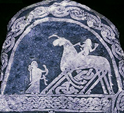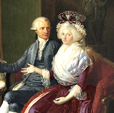Embroidery
 |
Thread had to be spun and dyed by hand, so it was relatively expensive. The embroidery stitch shown opposite, called "laid and couched" is designed to keep almost all the thread on the front surface of the design, so as to reduce wastage. The first layer of threads are stitched across back and forth over the area to be filled with only a tiny stitch at each end. Long expanses of thread are held down by the vertical stitches as shown here. |
| Stem stitch was used for decorative lines. The numbers 1-4 on the image show how the stitch is formed. It looks best when the twist of the stem stitch is opposite to the twist of the thread being used. |  |
Bibliography : Other web sites : |
|




